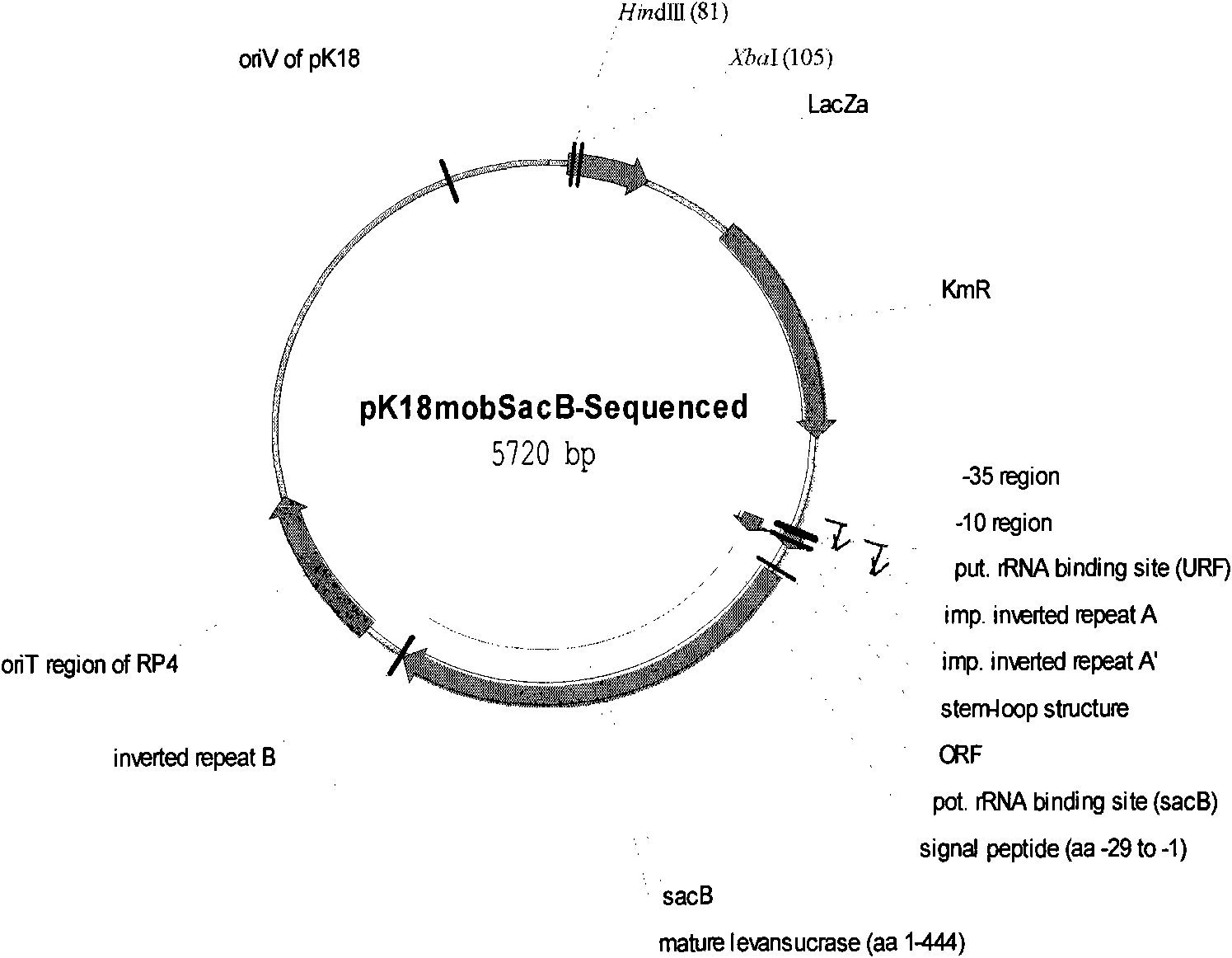Method for preparing hydroxyalkanoate homopolymer and special bacteria thereof
A technology of polyhydroxy fatty acid ester and hydroxy fatty acyl coenzyme, which is applied in the field of preparing hydroxy fatty acid ester homopolymer, and can solve the problem of not finding wild microbial strains and the like
- Summary
- Abstract
- Description
- Claims
- Application Information
AI Technical Summary
Problems solved by technology
Method used
Image
Examples
Embodiment 1
[0087] Embodiment 1, construction and biosynthesis of mutant strain Pseudomonas putida KTOY08
[0088] 1. Construction of mutant strain Pseudomonas putida KTOY08
[0089] (1) Construction of suicide plasmid pSPK09
[0090] 1) Using the genomic DNA of Pseudomonas putida strain KT2442 as a template, under the guidance of primers P1: ATTCTAGAGCTGAACCCGGATGGC and P2: AATAAGCTTGCCGAAGCGCAGGATC, PCR amplified two connected genes, 3-ketoacyl-CoA thiolase gene (fadAx) and 3-ketoacyl-CoA thiolase gene (fadAx) -Hydroxyacyl-CoA dehydrogenase gene (fadB2x), the PCR amplification product was double-digested with restriction endonucleases XbaI and HindIII, and the digested fragment with a size of about 2.7kb was recovered.
[0091] 2) Carry out double digestion of plasmid pK18mobSacB with restriction endonucleases XbaI and HindIII, and recover a digested fragment with a size of about 5.699 kb;
[0092] 3) Ligate the recovered fragments of step 1) and step 2) with T4DNA ligase, and after t...
Embodiment 2
[0137] Example 2, construction and biosynthesis of bacterial strain Pseudomonas putida KTOY08-G
[0138] 1. Construction of engineering strain Pseudomonas putida KTOY08-G
[0139] (1) Construction of recombinant vector pKQQ01
[0140] 1) Using the genomic DNA of Pseudomonas putida KT2442 as a template, PCR amplification was carried out with primers phaG-up-1 and phaG-up-2 to obtain the 3-hydroxyacyl apolipoprotein-CoA transferase gene (3-hydroxyacyl- The upstream fragment of acylcarrier protein-coenzyme A transferase (or PhaG) (sequence 3 in the sequence listing is shown in the 1-448th nucleotide from the 5' end); use restriction endonucleases XbaI and HindIII to PCR amplify the product Carry out double enzyme digestion, and recover the enzyme-cut fragment with a size of about 400bp;
[0141]Using the genomic DNA of Pseudomonas putida KT2442 as a template, PCR amplification was carried out with primers phaG-down-1 and phaG-down-2 to obtain the gene encoding 3-hydroxyacyl apo...
Embodiment 3
[0189] Example 3, construction of strain Pseudomonas putida KTHH06 and biosynthesis of PHA
[0190] Vector pKSSE5.3 (Hein S, B, Gottschalk G, Steinbüchel A. Biosynthesis of poly(4-hydroxybutyric acid) by recombinant strains of Escherichia coli. FEMS Microbiol. Lett. 1997; 153: 411-418.) (Provided by Tsinghua University);
[0191] The vector pKSSE5.3 contains the poly-β-hydroxybutyrate synthase coding gene (phbC gene) from the Ralstonia eutropha genome; the poly-β- The nucleotide sequence of the gene encoding hydroxybutyrate synthase (phbC gene) is shown as sequence 4 in the sequence listing, which is 1767bp.
[0192] Vector pBBR1-MCS2 (Michael E. Kovach, Philip H. Elzer, D. Steven Hill et al. Four new derivatives of the broad-host-range cloning vector pBBR1MCS, carrying different antibiotic-resistance cassettes. Gene. 1995; 166: 175-176 .) (provided by Tsinghua University);
[0193] The vector pBBR1-MCS2 contains the 4-hydroxybutyryl-CoA transferase encoding gene (orfZ gen...
PUM
| Property | Measurement | Unit |
|---|---|---|
| Number average molecular weight | aaaaa | aaaaa |
| Number average molecular weight | aaaaa | aaaaa |
| Number average molecular weight | aaaaa | aaaaa |
Abstract
Description
Claims
Application Information
 Login to View More
Login to View More - R&D
- Intellectual Property
- Life Sciences
- Materials
- Tech Scout
- Unparalleled Data Quality
- Higher Quality Content
- 60% Fewer Hallucinations
Browse by: Latest US Patents, China's latest patents, Technical Efficacy Thesaurus, Application Domain, Technology Topic, Popular Technical Reports.
© 2025 PatSnap. All rights reserved.Legal|Privacy policy|Modern Slavery Act Transparency Statement|Sitemap|About US| Contact US: help@patsnap.com



